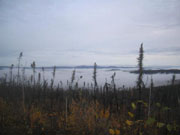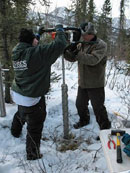-
(单词翻译:双击或拖选)
Melting Arctic Could be Major Source of Greenhouse Gases
The melting arctic permafrost could release methane1-producing microbes with the potential to accelerate climate change, according to a new study published in Nature.
Lead author Janet Jansson, senior scientist at the Lawrence Berkeley National Laboratory in California says the trapped microorganisms in permafrost are still active.
Jansson and colleagues at the U.S. Geological Survey and the Joint3 Genome Institute at the Department of Energy set out to identify microbes in permafrost and find out what they would do once thawed5.
“They had never been cultured," Jansson says. "So more than 90 percent of those bacteria and other microorganisms in permafrost, we had no idea what they were.”
 |
| Billions of metric tons of climate changing emissions6 could escape from the Alaskan permafrost as temperatures melt the frozen soils. |
The researchers analyzed7 three soil cores from the soft, peat floor of a black-spruce forest in central Alaska. A single gram of that soil could harbor thousands of different species and billions of cells.
Jansson says the fact that those microorganisms had never been grown in the laboratory made them difficult to study. What they did instead, she says, was to extract the total DNA8 from the samples. "We used a sequencing approach to get information about both the identities of the microorganisms and also all of the bio-chemical pathways that they had in the permafrost before and after thaw4.”
The team identified single-celled organisms that feast on organic material in the soil and produce methane, a greenhouse gas more potent2 than carbon dioxide. Jansson says methane-eaters were also among the microbes in the thawed permafrost. “Some of the methane was being consumed by other microorganisms in the samples, and they in turn would release, CO2, carbon dioxide.”
 |
| Core samples for microbial analysis are retrieved9 from the Alaskan permafrost. |
The scientists compared samples from the upper permafrost layer - which melts and refreezes seasonally10 - and the permanently11 frozen permafrost in which microbes have been trapped for millennia12.
While initially13 very different the two samples became more similar after thawing14, Jansson says. “Those two very disparate samples started to converge15, both the microorganisms that were present and also their functions started to converge and became much more similar to what we saw in the seasonally thawed active layer samples.”
Jansson says understanding how microbes respond during a thaw can help improve models that chart the earth’s climate.
 收听单词发音
收听单词发音
1
methane

|
|
| n.甲烷,沼气 | |
参考例句: |
|
|
|
2
potent

|
|
| adj.强有力的,有权势的;有效力的 | |
参考例句: |
|
|
|
3
joint

|
|
| adj.联合的,共同的;n.关节,接合处;v.连接,贴合 | |
参考例句: |
|
|
|
4
thaw

|
|
| v.(使)融化,(使)变得友善;n.融化,缓和 | |
参考例句: |
|
|
|
5
thawed

|
|
| 解冻 | |
参考例句: |
|
|
|
6
emissions

|
|
| 排放物( emission的名词复数 ); 散发物(尤指气体) | |
参考例句: |
|
|
|
7
analyzed

|
|
| v.分析( analyze的过去式和过去分词 );分解;解释;对…进行心理分析 | |
参考例句: |
|
|
|
8
DNA

|
|
| (缩)deoxyribonucleic acid 脱氧核糖核酸 | |
参考例句: |
|
|
|
9
retrieved

|
|
| v.取回( retrieve的过去式和过去分词 );恢复;寻回;检索(储存的信息) | |
参考例句: |
|
|
|
10
seasonally

|
|
参考例句: |
|
|
|
11
permanently

|
|
| adv.永恒地,永久地,固定不变地 | |
参考例句: |
|
|
|
12
millennia

|
|
| n.一千年,千禧年 | |
参考例句: |
|
|
|
13
initially

|
|
| adv.最初,开始 | |
参考例句: |
|
|
|
14
thawing

|
|
| n.熔化,融化v.(气候)解冻( thaw的现在分词 );(态度、感情等)缓和;(冰、雪及冷冻食物)溶化;软化 | |
参考例句: |
|
|
|
15
converge

|
|
| vi.会合;聚集,集中;(思想、观点等)趋近 | |
参考例句: |
|
|
|















